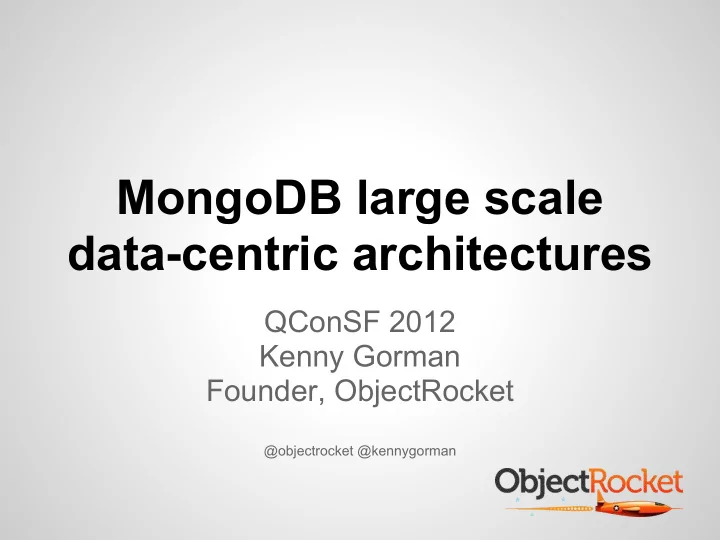

MongoDB large scale data-centric architectures QConSF 2012 Kenny Gorman Founder, ObjectRocket @objectrocket @kennygorman
MongoDB at scale ● Designing for scale ● Techniques to ease pain ● Things to avoid
What is scale? ● Scale; massive adoption/usage ● Scale; a very big, busy, or tricky system. ● Scale; I just want to sleep. ● Scale; The docs just seem silly now. ● Scale; Am I the only one with this problem?
Vintage playbook ● No joins, foreign keys, triggers, stored procs ● De-normalize until it hurts ● Split vertically, then horizontally. ○ Conventional wisdom. eBay an early pioneer. ● Many DBA's, Sysadmin's, storage engineers, etc ● Huge hardwarez ● You have your own datacenter or colo-location ● You realize your ORM has been screwing you ● You better have some clever folks on staff, shit gets weird at scale
Example: while True: try: add_column() exit() exception e: print ("%s; crud") % e
Vintage scaling playbook
Scaling today ● Many persistence store options ● Horizontal scalability is expected ● Cloud based architectures prevalent ○ Hardware and data centers are abstracted from developers ● Focus on rapid development ● Mostly developers, maybe some devops ● Expectations that stuff just works ● Technologies are less mature, less tunables
Enter MongoDB ● Document based NoSQL database ● JSON/BSON (www.bson.org) ● Developers dream ● OPS nightmare (for now) ● Schema-less ● Built in horizontal scaling framework ● Built in replication ● ~65% deployments in the cloud
MongoDB challenges ● The lock scope ● Visibility ● Schema ● When bad things happen
A MongoDB document { _id : ObjectId("4e77bb3b8a3e000000004f7a"), when : Date("2011-09-19T02:10:11.3Z", author : "alex", title : "No Free Lunch", text : "This is the text of the post", tags : [ "business", "ramblings" ], votes : 5, voters : [ "jane", "joe", "spencer" ], }
MongoDB keys for success at scale ● Design Matters!
Design for scale; macro level ● Keep it simple ● Break up workloads ● Tune your workloads ● NoORM; dump it ● Shard early ● Replicate ● Load test pre-production!
Your success is only as good as the thing you do a million times a second
Design for scale; specifics ● Embedded vs not ● Indexing ○ The right amount ○ Covered ● Atomic operations ● Use profiler and explain()
Example; document embedding // yes, guaranteed 1 i/o {userid: 100, post_id: 10, comments:["comment1","comment2"..]} db.blog.find({"userid":100}).explain() { ..., "nscannedObjects" : 1, ... } // no {userid: 100, post_id: 10, comment: "hi, this is kewl"} {userid: 100, post_id: 10, comment: "thats what you think"} {userid: 100, post_id: 10, comment: "I am thirsty"} db.blog.find({"userid":100}).explain() { ..., "nscannedObjects" : 3, ... }
Example; covered Indexes mongos> db.foo.find({"foo":1},{_id:0,"foo":1}).explain() { "cursor" : "BtreeCursor foo_-1", "isMultiKey" : false, "n" : 1, "nscannedObjects" : 1, "nscanned" : 1, "nscannedObjectsAllPlans" : 1, "nscannedAllPlans" : 1, "scanAndOrder" : false, "indexOnly" : true, "nYields" : 0, "nChunkSkips" : 0, "millis" : 0, "indexBounds" : { "foo" : [[1,1]]}, "millis" : 0 }
Design for scale ● Shard keys ● Tradeoffs ● Local vs Scattered ● Figure out at design time
Example; Shard Keys ● Tuning for writes ● Queries are scattered { _id: ObjectId("4e77bb3b8a3e000000004f7a"), skey: md5(userid+date), // shard key payload: {...} }
Example; Shard Keys ● Tuning for reads ○ Localized queries ○ Writes reasonably distributed { userid: 999, // shard key post: {"userid":23343, "capt":"hey checkout my pic", "url":"http://www.lolcats.com" } }
Design for scale; architecture ● Engage all processors ○ Single writer lock ○ Concurrency ● Replication ○ Understand elections, and fault zones ○ Understand the 'shell game', rebuilding slaves ■ Fragmentation ○ Client connections, getLastError ● Sharding ○ Pick good keys or die ○ Get enough I/O
Design for scale; architecture ● I/O ○ You need it ○ Conventional wisdom is wrong ○ Maybe they don't have big databases?
Example; 'shell game' Slave APP Perform work on slave then stepDown() back to Master primary Slave
Example; network partition ????? B A "replSet can't see a majority, will not try to elect self"
Example; write concern // ensure data is in local journal BasicDBObject doc = new BasicDBObject(); doc.put("payload","foo"); coll.insert(doc, WriteConcern.SAFE);
Random parting tips ● Monitor elections, and who is primary ● Write scripts to kill sessions > Nms or based on your architecture ● Automate or die ● Tools ○ Mongostat ○ Historical performance
Gotchas, risks, shit that will make you nuts ● Logical schema corruption ● That lock! ● Not enough I/O ● Engaging all processors ● Visibility ● Not understanding how MongoDB works ● FUD
Contact @kennygorman @objectrocket kgorman@objectrocket.com https://www.objectrocket.com https://github.com/objectrocket/rocketstat
Recommend
More recommend